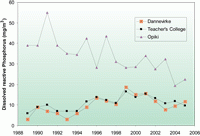Tracking water quality changes in the Manawatu River

There have been significant improvements in water quality in the lower Manawatu River over the last 15–20 years. At the same time, there have been other changes that indicate an increasing nutrient load entering the upper river.
In the 1980s, concern about the state of the Manawatu River below Palmerston North led to significant efforts to reduce contaminant inputs to the river from municipal and industrial discharges. Given these changes, we would expect to see a reduction in levels of organic pollution in the lower river, and this is exactly what long-term monitoring data from the National River Water Quality Network show.
Between 1989 and 2005, levels of organic pollution (BOD5) dropped significantly at Opiki Bridge, which is downstream of the major point source discharges to the river. But we are seeing some evidence of increasing concentrations of ammoniacal nitrogen (an indicator of the presence of toxic ammonia) at Opiki Bridge. This suggests there is scope for further improvements in management of point source discharges.
The most dramatic changes in water quality, however, relate to concentrations of nitrogen and phosphorus. Levels of total nitrogen have increased by 1–2% per year, with similar trends at all three sites on the river. Levels of dissolved phosphorus increased by more than 4% per year at Dannevirke, but – by contrast – they have decreased significantly at Opiki Bridge (–3.7% per year), as shown on the graph above.
What this tells us is that controls on phosphorus loads entering the river below Palmerston North appear to be paying dividends, but the river is still under pressure from land-use intensification upstream of the city.
